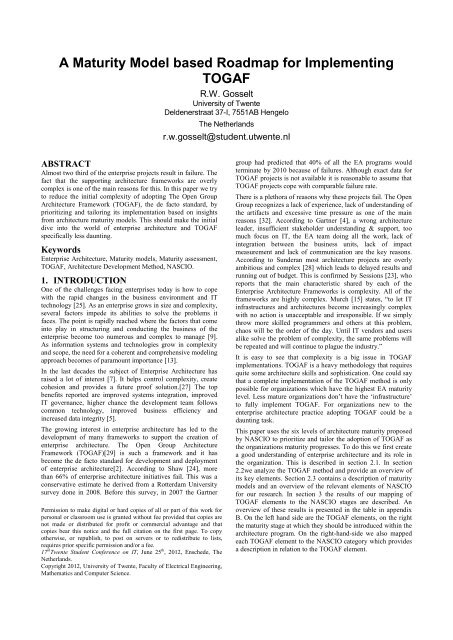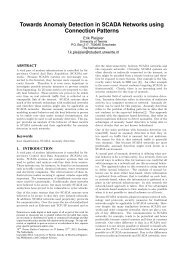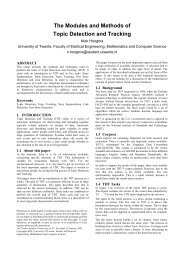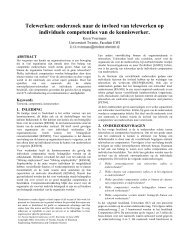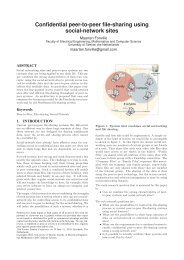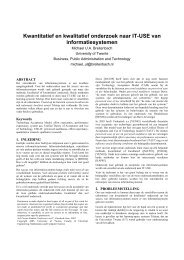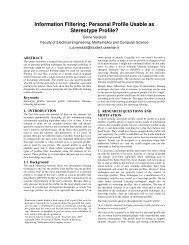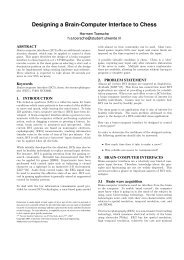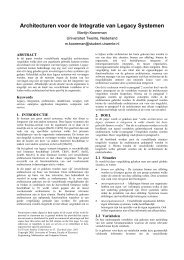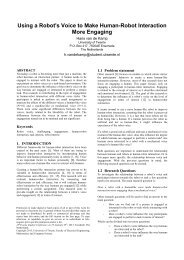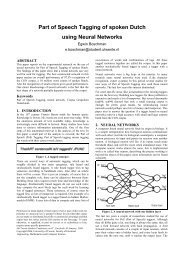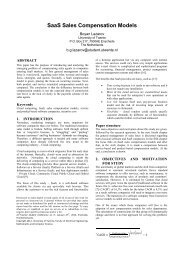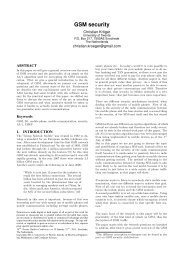A Maturity Model based Roadmap for Implementing TOGAF
A Maturity Model based Roadmap for Implementing TOGAF
A Maturity Model based Roadmap for Implementing TOGAF
You also want an ePaper? Increase the reach of your titles
YUMPU automatically turns print PDFs into web optimized ePapers that Google loves.
A <strong>Maturity</strong> <strong>Model</strong> <strong>based</strong> <strong>Roadmap</strong> <strong>for</strong> <strong>Implementing</strong><br />
<strong>TOGAF</strong><br />
R.W. Gosselt<br />
University of Twente<br />
Deldenerstraat 37-I, 7551AB Hengelo<br />
The Netherlands<br />
r.w.gosselt@student.utwente.nl<br />
ABSTRACT<br />
Almost two third of the enterprise projects result in failure. The<br />
fact that the supporting architecture frameworks are overly<br />
complex is one of the main reasons <strong>for</strong> this. In this paper we try<br />
to reduce the initial complexity of adopting The Open Group<br />
Architecture Framework (<strong>TOGAF</strong>), the de facto standard, by<br />
prioritizing and tailoring its implementation <strong>based</strong> on insights<br />
from architecture maturity models. This should make the initial<br />
dive into the world of enterprise architecture and <strong>TOGAF</strong><br />
specifically less daunting.<br />
Keywords<br />
Enterprise Architecture, <strong>Maturity</strong> models, <strong>Maturity</strong> assessment,<br />
<strong>TOGAF</strong>, Architecture Development Method, NASCIO.<br />
1. INTRODUCTION<br />
One of the challenges facing enterprises today is how to cope<br />
with the rapid changes in the business environment and IT<br />
technology [25]. As an enterprise grows in size and complexity,<br />
several factors impede its abilities to solve the problems it<br />
faces. The point is rapidly reached where the factors that come<br />
into play in structuring and conducting the business of the<br />
enterprise become too numerous and complex to manage [9].<br />
As in<strong>for</strong>mation systems and technologies grow in complexity<br />
and scope, the need <strong>for</strong> a coherent and comprehensive modeling<br />
approach becomes of paramount importance [13].<br />
In the last decades the subject of Enterprise Architecture has<br />
raised a lot of interest [7]. It helps control complexity, create<br />
cohesion and provides a future proof solution.[27] The top<br />
benefits reported are improved systems integration, improved<br />
IT governance, higher chance the development team follows<br />
common technology, improved business efficiency and<br />
increased data integrity [5].<br />
The growing interest in enterprise architecture has led to the<br />
development of many frameworks to support the creation of<br />
enterprise architecture. The Open Group Architecture<br />
Framework ( <strong>TOGAF</strong>)[29] is such a framework and it has<br />
become the de facto standard <strong>for</strong> development and deployment<br />
of enterprise architecture[2]. According to Shaw [24], more<br />
than 66% of enterprise architecture initiatives fail. This was a<br />
conservative estimate he derived from a Rotterdam University<br />
survey done in 2008. Be<strong>for</strong>e this survey, in 2007 the Gartner<br />
Permission to make digital or hard copies of all or part of this work <strong>for</strong><br />
personal or classroom use is granted without fee provided that copies are<br />
not made or distributed <strong>for</strong> profit or commercial advantage and that<br />
copies bear this notice and the full citation on the first page. To copy<br />
otherwise, or republish, to post on servers or to redistribute to lists,<br />
requires prior specific permission and/or a fee.<br />
17 th Twente Student Conference on IT, June 25 th , 2012, Enschede, The<br />
Netherlands.<br />
Copyright 2012, University of Twente, Faculty of Electrical Engineering,<br />
Mathematics and Computer Science.<br />
group had predicted that 40% of all the EA programs would<br />
terminate by 2010 because of failures. Although exact data <strong>for</strong><br />
<strong>TOGAF</strong> projects is not available it is reasonable to assume that<br />
<strong>TOGAF</strong> projects cope with comparable failure rate.<br />
There is a plethora of reasons why these projects fail. The Open<br />
Group recognizes a lack of experience, lack of understanding of<br />
the artifacts and excessive time pressure as one of the main<br />
reasons [32]. According to Gartner [4], a wrong architecture<br />
leader, insufficient stakeholder understanding & support, too<br />
much focus on IT, the EA team doing all the work, lack of<br />
integration between the business units, lack of impact<br />
measurement and lack of communication are the key reasons.<br />
According to Sunderan most architecture projects are overly<br />
ambitious and complex [28] which leads to delayed results and<br />
running out of budget. This is confirmed by Sessions [23], who<br />
reports that the main characteristic shared by each of the<br />
Enterprise Architecture Frameworks is complexity. All of the<br />
frameworks are highly complex. Murch [15] states, “to let IT<br />
infrastructures and architectures become increasingly complex<br />
with no action is unacceptable and irresponsible. If we simply<br />
throw more skilled programmers and others at this problem,<br />
chaos will be the order of the day. Until IT vendors and users<br />
alike solve the problem of complexity, the same problems will<br />
be repeated and will continue to plague the industry.”<br />
It is easy to see that complexity is a big issue in <strong>TOGAF</strong><br />
implementations. <strong>TOGAF</strong> is a heavy methodology that requires<br />
quite some architecture skills and sophistication. One could say<br />
that a complete implementation of the <strong>TOGAF</strong> method is only<br />
possible <strong>for</strong> organizations which have the highest EA maturity<br />
level. Less mature organizations don’t have the ‘infrastructure’<br />
to fully implement <strong>TOGAF</strong>. For organizations new to the<br />
enterprise architecture practice adopting <strong>TOGAF</strong> could be a<br />
daunting task.<br />
This paper uses the six levels of architecture maturity proposed<br />
by NASCIO to prioritize and tailor the adoption of <strong>TOGAF</strong> as<br />
the organizations maturity progresses. To do this we first create<br />
a good understanding of enterprise architecture and its role in<br />
the organization. This is described in section 2.1. In section<br />
2.2we analyze the <strong>TOGAF</strong> method and provide an overview of<br />
its key elements. Section 2.3 contains a description of maturity<br />
models and an overview of the relevant elements of NASCIO<br />
<strong>for</strong> our research. In section 3 the results of our mapping of<br />
<strong>TOGAF</strong> elements to the NASCIO stages are described. An<br />
overview of these results is presented in the table in appendix<br />
B. On the left hand side are the <strong>TOGAF</strong> elements, on the right<br />
the maturity stage at which they should be introduced within the<br />
architecture program. On the right-hand-side we also mapped<br />
each <strong>TOGAF</strong> element to the NASCIO category which provides<br />
a description in relation to the <strong>TOGAF</strong> element.
2. RELATED WORK<br />
2.1 Enterprise Architecture<br />
Enterprise architecture (EA) has the purpose to optimize, across<br />
the enterprise, the often fragmented legacy of processes (both<br />
manual and automated) into an integrated environment, that is<br />
responsive to change and supports the achievement of the<br />
business strategy[29]. EA can be used by organizations to<br />
per<strong>for</strong>m strategic planning and develop “blueprints” of their<br />
future-state. EA is also used as a management tool to ensure<br />
planning and activities are aligned with the strategic goals of<br />
the organization, and to identify opportunities <strong>for</strong> collaboration<br />
and reuse of resources across an organization[25].<br />
An architecture may be viewed as a set of rules, guidelines and<br />
patterns <strong>for</strong> describing the architecture of systems.[18] The ISO<br />
42010 standard [8] describes architecture as the fundamental<br />
organization of a system embodied in its components, their<br />
relationships to each other, and to the environment, and the<br />
principles guiding its design and evolution.<br />
The Open Group [29] defines ”enterprise” as any collection of<br />
organizations that has a common set of goals. For example, an<br />
enterprise could be a government agency, a whole corporation,<br />
a division of a corporation, a single department, or a chain of<br />
geographically distant organizations linked together by<br />
common ownership. The term “enterprise” in the context of<br />
“enterprise architecture” can be used to denote both an entire<br />
enterprise —encompassing all of its in<strong>for</strong>mation and technology<br />
services, processes, and infrastructure —and a specific domain<br />
within the enterprise. In both cases, the architecture crosses<br />
multiple systems, and multiple functional groups within the<br />
enterprise.<br />
Most enterprise architecture frameworks (EAFs) provide a<br />
definition of enterprise architecture. These definitions share<br />
commonalities that EA is about a set of models including their<br />
components and how these components integrate and work<br />
together to achieve a specific goal [14]. It is important to<br />
understand that Enterprise Architecture is not limited to IT, but<br />
is a company wide ef<strong>for</strong>t [21].<br />
According to Lankhorst et al.[12] enterprise architecture (i)<br />
offers a holistic perspective of the current and future operations,<br />
and on the actions that should be taken to achieve the<br />
company’s goals. It is (ii) an important asset in positioning new<br />
developments within the context of the existing processes, IT<br />
systems, and other assets of an organization, and it helps in<br />
identifying necessary changes. Thus, good architectural practice<br />
helps a company innovate and change by providing both<br />
stability and flexibility. The insights provided by an enterprise<br />
architecture are needed on the one hand in determining the<br />
needs and priorities <strong>for</strong> change from a business perspective, and<br />
on the other hand in assessing how the company may benefit<br />
from technological innovations. And EA is a (iii) valuable asset<br />
in the complex and diverse world of business-IT alignment. The<br />
business-IT alignment is <strong>based</strong> on a well-known strategic<br />
alignment model of Henderson and Venkatraman[6] which<br />
distinguishes between the aspects of business strategy and<br />
organizational infrastructure on the one hand, and IT strategy<br />
and IT infrastructure on the other hand.<br />
Lankhorst et al. [12] positioned enterprise architecture within<br />
the context of the enterprise. This is visualized in the <strong>for</strong>m of a<br />
pyramid show in Figure 1. At the top of this pyramid, we see<br />
the mission of the enterprise: why does it exist The vision<br />
states its ‘image of the future’ and the values the enterprise<br />
holds. Next there is its strategy, which states the route the<br />
enterprise will take in achieving this mission and vision. This is<br />
translated into concrete goals that give direction and provide the<br />
milestones in executing the strategy. Translating those goals<br />
into concrete changes to the daily operations of the company is<br />
where enterprise architecture comes into play. It offers a<br />
holistic perspective of the current and future operations, and on<br />
the actions that should be taken to achieve the company’s goals.<br />
Figure 1. Enterprise architecture positioned within the<br />
organizations context (Lankhorst et. al.)<br />
Architecture has three value creating potentials: innovativeness,<br />
responsiveness and economies of scale [11]. Organizations with<br />
highly capable infrastructure will have greater tendency to<br />
innovate with in<strong>for</strong>mation technology. Higher levels of IT<br />
infrastructure capabilities will be more responsive at adapting<br />
their in<strong>for</strong>mation systems to accommodate changing business<br />
conditions. The development cost and time of business<br />
application systems will generally be lower <strong>for</strong> firms with more<br />
capable IT infrastructures.<br />
2.2 Enterprise architecture frameworks<br />
With the growing use of EA, architects have an increasing need<br />
<strong>for</strong> instruments to manage, to define, realize and communicate<br />
demands on the architecture [10]. An enterprise architecture<br />
framework (EAF) provides such an instrument. Enterprise<br />
architecture frameworks are commonly used to develop a single<br />
cohesive model that encompasses all aspects of a business in<br />
support of business and IT initiatives. A well-developed EA<br />
optimizes business processes by eliminating redundancy,<br />
contradictions and identifying gaps [17]. EAFs help<br />
organizations to build target-con<strong>for</strong>mant enterprise architecture<br />
that is flexible, adaptable and efficient [25]. The four most used<br />
Enterprise Architecture Frameworks are the Zachman<br />
Framework, The Open Group Architecture Framework<br />
(<strong>TOGAF</strong>), Federal Architecture Framework (FEA) and the<br />
Gartner Methodology.<br />
2.2.1 <strong>TOGAF</strong><br />
<strong>TOGAF</strong> is growingly considered to be the de facto standard<br />
way of working <strong>for</strong> the development and deployment of modern<br />
IT systems in enterprises [2]. <strong>TOGAF</strong> is freely available to<br />
members and non-members and has gained a market<br />
penetration of 50% according to its own figures [19].<br />
Ohren[18], made some ef<strong>for</strong>ts of characterizing available EAFs.<br />
From his architecture framework ontology can be concluded<br />
that <strong>TOGAF</strong> distinguishes itself by the development of an<br />
architecture repository to support the organization of re-usable<br />
architectures. <strong>TOGAF</strong> is not wholly specific with respect to<br />
generated documents; in fact, it provides very little in the way<br />
of prescriptive document templates—merely guidelines <strong>for</strong><br />
inputs and outputs [20].<br />
In a comparison of the be<strong>for</strong>e mentioned four 'frameworks'<br />
Sessions [22] states that <strong>TOGAF</strong>, although self-described as a
framework, it is actually more accurately defined as a process.<br />
He comes to this conclusion because the Architecture<br />
Development Method is the most visible and important part of<br />
the <strong>TOGAF</strong> framework, which is a process <strong>for</strong> creating the<br />
architecture artifacts.<br />
Figure 2. Phases in the <strong>TOGAF</strong> Architecture Development<br />
Method<br />
The Architectural Development Method (ADM) is a detailed,<br />
step-by-step method on how to build, maintain, and implement<br />
an enterprise architecture. It consists out of 8 different steps in<br />
the design cycle. See figure 2. These phases are an indication<br />
however, because <strong>TOGAF</strong> is flexible with respect to the phases.<br />
As the specification itself says: One of the tasks be<strong>for</strong>e applying<br />
the ADM is to review its components <strong>for</strong> applicability, and then<br />
tailor them as appropriate to the circumstances of the individual<br />
enterprise. This activity might well produce an "enterprisespecific"<br />
ADM [29]. <strong>TOGAF</strong> allows phases to be done<br />
incompletely, skipped, combined, reordered, or reshaped to fit<br />
the needs of the situation [22].<br />
Appendix B contains an overview off the most important<br />
elements of the <strong>TOGAF</strong> method. Next we will describe these<br />
elements to get a better understanding of what they are.<br />
Architecture development Method (ADM) , the development<br />
process, is the most visual element of <strong>TOGAF</strong>. The ADM<br />
provides a tested and repeatable process <strong>for</strong> developing<br />
architectures. The ADM includes establishing an architecture<br />
framework, developing architecture content, transitioning, and<br />
governing the realization of architectures. All of these activities<br />
are carried out within an iterative cycle of continuous<br />
architecture definition and realization that allows organizations<br />
to trans<strong>for</strong>m their enterprises in a controlled manner in response<br />
to business goals and opportunities.<br />
The Architecture Board oversees the implementation of the<br />
governance strategy. This body should be representative of all<br />
the key stakeholders in the architecture.<br />
Architecture Compliance Assessment. Once an architecture has<br />
been defined, it is necessary to govern that architecture through<br />
implementation to ensure that the original Architecture Vision<br />
is appropriately realized and that any implementation lessons<br />
are fed back into the architecture process. Period compliance<br />
reviews of implementation projects provide a mechanism to<br />
review project progress and ensure that the design and<br />
implementation is proceeding in-line with the strategic and<br />
architectural objectives.<br />
Architecture Contracts are the joint agreements between<br />
development partners and sponsors on the deliverables, quality,<br />
and fitness-<strong>for</strong>-purpose of an architecture.<br />
The Architecture Governance Framework supports the<br />
architecture governance by assisting the identification of<br />
effective processes and organizational structures, so that the<br />
business responsibilities associated with architecture<br />
governance can be clarified, communicated, and managed<br />
effectively Architecture governance is the practice and<br />
orientation by which enterprise architectures and other<br />
architectures are managed and controlled at an enterprise-wide<br />
level. It includes systems to control over the creation and<br />
monitoring of all architectural components and activities.<br />
Ensuring compliance with internal and external standards and<br />
regulations and ensuring accountability to the stakeholders.<br />
Phase G of the <strong>TOGAF</strong> ADM is dedicated to the<br />
implementation governance.<br />
The Architecture skills framework provides a set of roles, skills,<br />
and experience norms <strong>for</strong> staff undertaking enterprise<br />
architecture work.<br />
The Architectural content framework provides a structural<br />
model <strong>for</strong> architectural content that allows the major work<br />
products that an architect creates to be consistently defined,<br />
structured, and presented.<br />
Architecture Building Blocks (ABBs) typically describe required<br />
capability and shape the specification of Solution Building<br />
Blocks (SBBs). For example, a customer services capability<br />
may be required within an enterprise, supported by many SBBs,<br />
such as processes, data, and application software. Solution<br />
Building Blocks (SBBs) represent components that will be used<br />
to implement the required capability. For example, a network is<br />
a building block that can be described through complementary<br />
artifacts and then put to use to realize solutions <strong>for</strong> the<br />
enterprise.<br />
The Architecture Definition Document is the deliverable<br />
container <strong>for</strong> the core architectural artifacts created during a<br />
project and <strong>for</strong> important related in<strong>for</strong>mation. The Architecture<br />
Definition Document spans all architecture domains (business,<br />
data, application, and technology) and also examines all<br />
relevant states of the architecture (baseline, transition, and<br />
target). The Architecture Definition Document provides a<br />
qualitative view of the solution and aims to communicate the<br />
intent of the architect.<br />
A Transition Architecture shows the enterprise at an<br />
architecturally significant state between the Baseline and Target<br />
Architectures. Transition Architectures are used to describe<br />
transitional Target Architectures necessary <strong>for</strong> effective<br />
realization of the Target Architecture.<br />
Architecture Patterns are a technique <strong>for</strong> putting building<br />
blocks into context. Patterns can be used to describe a re-usable<br />
solution to a problem. Building blocks are what you use.<br />
Patterns can tell you how you use them, when, why, and what<br />
trade-offs you have to make in doing so.
Architecture Principles are a qualitative statement of intent that<br />
should be met by the architecture. They have at least a<br />
supporting rationale and a measure of importance. Principles<br />
are general rules and guidelines, intended to be enduring and<br />
seldom amended, that in<strong>for</strong>m and support the way in which an<br />
organization sets about fulfilling its mission. We differentiate<br />
Business, Data, Application and Technology principles.<br />
The Architecture Repository acts as a holding area <strong>for</strong> all<br />
architecture-related projects within the enterprise. The<br />
repository allows projects to manage their deliverables, locate<br />
re-usable assets, and publish outputs to stakeholders and other<br />
interested parties. Part of the repository is the Reference library<br />
which provides guidelines, templates, patterns, and other <strong>for</strong>ms<br />
of reference material that can be leveraged in order to accelerate<br />
the creation of new architectures <strong>for</strong> the enterprise. Another<br />
important aspect of the repository is the Standards in<strong>for</strong>mation<br />
base which captures the standards to which new architectures<br />
must comply. They may include industry standards, selected<br />
products and services from suppliers, or shared services already<br />
deployed within the organization.<br />
The Architecture Metamodel describes the organizationally<br />
tailored application of an architecture framework, including a<br />
method <strong>for</strong> architecture development and a metamodel <strong>for</strong><br />
architecture content.<br />
The Architecture Requirements Specification provides a<br />
quantitative view of the solution, stating measurable criteria that<br />
must be met during the implementation of the architecture.<br />
The Architecture <strong>Roadmap</strong> lists individual work packages that<br />
will realize the Target Architecture and lays them out on a<br />
timeline to show progression from the Baseline Architecture to<br />
the Target Architecture. The Architecture <strong>Roadmap</strong> is<br />
incrementally developed throughout Phases E and F, and<br />
in<strong>for</strong>med by readily identifiable roadmap components from<br />
Phase B, C, and D within the ADM.<br />
The Architecture Vision is created early on in the ADM cycle. It<br />
provides a summary of the changes to the enterprise that will<br />
accrue from successful deployment of the Target Architecture.<br />
The purpose of the Architecture Vision is to provide key<br />
stakeholders with a <strong>for</strong>mally agreed outcome.<br />
Business principles, business goals, and business drivers<br />
provide context <strong>for</strong> architecture work, by describing the needs<br />
and ways of working employed by the enterprise. Many factors<br />
that lie outside the consideration of architecture discipline may<br />
nevertheless have significant implications <strong>for</strong> the way that<br />
architecture is developed.<br />
Capability assessments are used to identify the abilities that an<br />
organization possesses. Capabilities are typically expressed in<br />
general and high-level terms and typically require a<br />
combination of organization, people, processes, and technology<br />
to achieve. We differentiate a business capability assessment,<br />
IT capability assessment, architecture maturity assessment and<br />
a Business trans<strong>for</strong>mation readiness assessment. The latter<br />
provides insight in the readiness of the organization to accept<br />
change. Identifying readiness issues and then dealing with them<br />
in the Implementation and Migration Plans is vital <strong>for</strong> a<br />
successful architecture trans<strong>for</strong>mation in Phases E and F.<br />
A Change Request is a document containing a call <strong>for</strong> an<br />
adjustment of the architecture; it may be submitted in order to<br />
kick-start a further cycle of architecture work.<br />
The development of a Communications Plan allows <strong>for</strong><br />
effective communication, of targeted in<strong>for</strong>mation to the right<br />
stakeholders at the right time through the right channels, to be<br />
carried out within a planned and managed process.<br />
The Enterprise Continuum is a categorization mechanism useful<br />
<strong>for</strong> classifying architecture artifacts (Architecture continuum)<br />
and solution artifacts (Solutions continuum), both internal and<br />
external to the Architecture Repository, as they evolve from<br />
generic Foundation Architectures to Organization-Specific<br />
Architectures.<br />
The Implementation and Migration Plan provides a schedule of<br />
the projects that will realize the Target Architecture. The<br />
Implementation and Migration Plan includes executable<br />
projects grouped into managed portfolios and programs. A key<br />
element of the Implementation and Migration Plan is the<br />
Implementation and Migration Strategy which provides<br />
strategic implementation direction and an implementation<br />
sequencing approach.<br />
The Implementation Governance <strong>Model</strong> ensures that a project<br />
transitioning into implementation also smoothly transitions into<br />
appropriate architecture governance. It does so by defining<br />
specific processes, organizations, roles, responsibilities, and<br />
measures on a project-by-project basis.<br />
Interoperability requirements define the degree to which the<br />
in<strong>for</strong>mation, business processes and services are to be shared.<br />
As part of the change management phase Monitoring Tools are<br />
deployed that monitor <strong>for</strong> technology and business changes that<br />
impact the baseline architecture. They could eventually lead to<br />
change requests.<br />
The Organizational model contains the scope of organizations<br />
impacted, budget requirements, roles and responsibilities (<strong>for</strong><br />
architecture teams) and a governance and support strategy.<br />
A Request <strong>for</strong> architecture work is a document that is sent from<br />
the sponsoring organization to the architecture organization to<br />
trigger the start of an architecture development cycle. Requests<br />
<strong>for</strong> Architecture Work can be created as an output of the<br />
Preliminary Phase, a result of approved architecture Change<br />
Requests, or terms of reference <strong>for</strong> architecture work<br />
originating from migration planning.<br />
A Requirements Impact Assessment assesses the current<br />
architecture requirements and specification to identify changes<br />
that should be made and the implications of those changes.<br />
Risk management. There will always be risk with any<br />
architecture/business trans<strong>for</strong>mation ef<strong>for</strong>t. It is important to<br />
identify, classify (assessment), and mitigate these risks be<strong>for</strong>e<br />
starting so that they can be tracked (monitoring) throughout the<br />
trans<strong>for</strong>mation ef<strong>for</strong>t. It is within the governance framework<br />
that the risks have to be accepted and then managed.<br />
Stakeholder Management is an important discipline that<br />
successful architecture practitioners can use to win support<br />
from others. Stakeholder management helps ensure stakeholders<br />
support and their input improves the quality of the models<br />
produced. Stakeholders are people who have key roles in, or<br />
concerns about, the system. Different stakeholders with<br />
different roles in the system will have different concerns.<br />
Stakeholders can be individuals, teams, or organizations (or<br />
classes thereof). Concerns are the key interests that are crucially<br />
important to the stakeholders in the system, and determine the<br />
acceptability of the system.<br />
The Statement of Architecture Work defines the scope and<br />
approach that will be used to complete an architecture<br />
development cycle. The Statement of Architecture Work is<br />
typically the document against which successful execution of<br />
the architecture project will be measured and may <strong>for</strong>m the<br />
basis <strong>for</strong> a contractual agreement between the supplier and<br />
consumer of architecture services.
Tailored architecture framework. Be<strong>for</strong>e <strong>TOGAF</strong> can be<br />
effectively used within an architecture project the <strong>TOGAF</strong><br />
model needs to be tailored <strong>for</strong> integration into the enterprise and<br />
also tailored <strong>for</strong> the specific architecture project. This tailoring<br />
will include integration with project and process management<br />
frameworks, customization of terminology, development of<br />
presentational styles, selection, configuration, and deployment<br />
of architecture tools, etc. The <strong>for</strong>mality and detail of any<br />
frameworks adopted should also align with the organizational<br />
context, such as culture, stakeholders, commercial models <strong>for</strong><br />
enterprise architecture, and the existing level of Architecture<br />
Capability.<br />
The Technical reference model (TRM) is a taxonomy that<br />
categorizes a set of technology areas and their relationships at a<br />
conceptual level. It establishes a common structure and<br />
vocabulary <strong>for</strong> describing technology components.<br />
Solution development & deployment. During Phase G<br />
(Implementation & Migration) the actual solution is<br />
implemented and deployed. This is not a direct output of the<br />
architecture development process. But because of its<br />
importance it is also listed as an element of <strong>TOGAF</strong>.<br />
2.3 <strong>Maturity</strong> models<br />
<strong>Maturity</strong> models date back to the early seventies. In contrast to<br />
popular believe the first application of a staged maturity model<br />
to IT was not by CMM/SEI, but rather by Richard L. Nolan,<br />
who, in 1973 published the stages of growth model <strong>for</strong> IT<br />
organizations. The Capability <strong>Maturity</strong> <strong>Model</strong> (CMM) was<br />
originally developed as a tool <strong>for</strong> objectively assessing the<br />
ability of government contractors' processes to per<strong>for</strong>m a<br />
contracted software project. The CMM is <strong>based</strong> on the process<br />
maturity framework first described in the 1989 book Managing<br />
the Software Process by Watts Humphrey. It was later<br />
published in a report in 1993 (Technical Report CMU/SEI-93-<br />
TR-024 ESC-TR-93-177 February 1993, Capability <strong>Maturity</strong><br />
<strong>Model</strong> <strong>for</strong> Software, Version 1.1) and as a book by the same<br />
authors in 1995.<br />
The CMM model proved useful to many organizations, but its<br />
application in software development has sometimes been<br />
problematic. Applying multiple models that are not integrated<br />
within and across an organization could be costly in training,<br />
appraisals, and improvement activities. The Capability <strong>Maturity</strong><br />
<strong>Model</strong> Integration (CMMI) project was <strong>for</strong>med to sort out the<br />
problem of using multiple CMMs.[31] For software<br />
development processes, the CMM has been superseded by<br />
CMMI, though the CMM continues to be a general theoretical<br />
process capability model used in the public domain. CMMI was<br />
developed by the CMMI project, which aimed to improve the<br />
usability of maturity models by integrating many different<br />
models into one framework. The project consisted of members<br />
of industry, government and the Carnegie Mellon Software<br />
Engineering Institute (SEI).<br />
<strong>Maturity</strong> models can be categorized in one of two types of<br />
maturity models [26]. (i) Staged models: These models<br />
distinguish five levels of maturity. For each level a number of<br />
focus areas are defined specific to that level. These focus areas<br />
have to be implemented satisfactorily <strong>for</strong> the organization to<br />
achieve that particular level. (ii) Continuous models: These<br />
models also distinguish five general maturity levels and a<br />
number of focus areas. The difference with the first kind of<br />
models is that the focus areas are not attributed to a level, but<br />
within each focus area the 5 levels are distinguished.<br />
2.4 Enterprise architecture maturity models<br />
With the emergence of enterprise architecture also a lot of<br />
maturity models specifically tailored <strong>for</strong> enterprise architecture<br />
were developed.[1,3,16,26]<br />
According to NASCIO an essential part of enterprise<br />
architecture development is <strong>for</strong> the organizations to assess their<br />
current situation, and then set goals <strong>for</strong> the future. Identifying<br />
the maturity of EA Architecture program components <strong>for</strong>mally<br />
allows the organization to benchmark the status of current<br />
programs and begin the process of improving their<br />
effectiveness, or kick off a new program.[16]<br />
Architecture Capability <strong>Maturity</strong> <strong>Model</strong>s (ACMMs) provide an<br />
effective and proven method <strong>for</strong> an organization to gradually<br />
gain control over and improve its architecture change processes.<br />
By describing process improvement practices and a framework<br />
to measure that improvement. A maturity model is not only<br />
suitable as an assessment tool of the current state of the<br />
architecture. It could also be used as a roadmap of steps to take<br />
to improve the enterprise architecture [30].<br />
2.5 NASCIO<br />
One of the most used models is the National Association of<br />
State Chief In<strong>for</strong>mation Officers ( NASCIO) Enterprise<br />
architecture maturity model [14,29]. It is also proposed by<br />
<strong>TOGAF</strong> to per<strong>for</strong>m Enterprise architecture maturity<br />
assessments.<br />
The model is <strong>based</strong> on the Capability <strong>Maturity</strong> <strong>Model</strong><br />
developed by the Software Engineering Institute (SEI).<br />
NASCIO describes the intent of the model as: “to supply a tool<br />
that can be used to benchmark the effectiveness of an Enterprise<br />
Architecture program. It also illustrates the natural progression<br />
of benefits that a supported and managed architecture program<br />
will contribute to an organization as it matures.”<br />
NASCIO organizes its maturity descriptions by 8 different<br />
categories:<br />
Architecture Planning ensures the program is managed to<br />
assure the goals <strong>for</strong> implementation are realistic and achievable<br />
and the program is kept within scope.<br />
Architecture Framework consists of the processes, templates<br />
and <strong>for</strong>ms used by those documenting the operations and<br />
standards of the organization.<br />
Architecture Blueprint refers to the completed documents that<br />
are prepared using the Architecture Framework processes,<br />
templates and <strong>for</strong>ms. The Blueprint refers to the documented<br />
products and standards, together with their detail,<br />
classifications, impact statements, and migration strategies.<br />
Communication is the element that ensures standards and<br />
processes are established and readily available to team members<br />
<strong>for</strong> reference and use. As an organization changes and<br />
programs evolve the continued communication ensures the EA<br />
program remains vital and operates optimally.<br />
Compliance must be reviewed periodically to be sure the<br />
business and IT programs and services are operating effectively.<br />
Integration addresses the ability of the various entities (internal<br />
or external to the organization) to coordinate their ef<strong>for</strong>ts to the<br />
greatest benefit of the organization. This is a key factor, as<br />
great efficiencies are gained by identifying similar functions or<br />
operations, both inside and outside of an organization.<br />
Involvement must be part of an EA Program. Without the<br />
support of managers and employees who are expected to utilize<br />
and follow the defined process, the program is sure to fail.
The maturity model is a staged model which differentiates 6<br />
stages of maturity, from no program (immature) to a<br />
continuously improved program (mature). We will give a short<br />
description of each of these stages. Appendix A contains a more<br />
in-depth description of the (<strong>for</strong> our research relevant) elements<br />
in each of the 6 stages. Or consult the NASCIO maturity model<br />
document <strong>for</strong> a more detailed description <strong>for</strong> each of the<br />
different stages[16].<br />
Level 0: No program. At this level there is not a documented<br />
architectural framework in place at this level of maturity.<br />
While solutions are developed and implemented, this is done<br />
with no recognized standards or base practices. The<br />
organization is completely reliant on the knowledge of<br />
independent contributors.<br />
Level 1: In<strong>for</strong>mal program. The base architecture framework<br />
and standards have been defined and are typically per<strong>for</strong>med<br />
in<strong>for</strong>mally. There is general consensus that these steps should<br />
be per<strong>for</strong>med, however they may not be tracked and followed.<br />
Organizations with an Enterprise Architecture framework at this<br />
level are still dependent on the knowledge of individual<br />
contributors.<br />
Level 2: Repeatable program. The base architecture and<br />
standards have been identified and are being tracked and<br />
verified. At this point in the program processes are repeatable<br />
and reusable templates are starting to be developed. The need<br />
<strong>for</strong> product and compliance components to con<strong>for</strong>m to the<br />
standards and requirements has been agreed upon, and metrics<br />
are used to track process area per<strong>for</strong>mance.<br />
Level 3: Well-defined program. The enterprise architecture<br />
framework is well defined; using approved standard and/or<br />
customized versions of the templates. Processes are<br />
documented across the organization. Per<strong>for</strong>mance metrics are<br />
being tracked and monitored in relationship to other general<br />
practices and process areas.<br />
Level 4: Managed program. At this point per<strong>for</strong>mance metrics<br />
are collected, analyzed and acted upon. The metrics are used to<br />
predict per<strong>for</strong>mance and provide better understanding of the<br />
processes and capabilities.<br />
Level 5: Continuously improved program. The processes are<br />
mature; targets have been set <strong>for</strong> effectiveness and efficiency<br />
<strong>based</strong> on business and technical goals. There are ongoing<br />
refinements and improvements <strong>based</strong> on the understanding of<br />
the impact changes have to these processes.<br />
3. USE OF <strong>TOGAF</strong> IN EACH LEVEL<br />
With every level of architecture maturity more elements of<br />
<strong>TOGAF</strong> should be adopted in the EA process. In this chapter<br />
we will describe these elements <strong>for</strong> each of the maturity levels.<br />
Because a higher maturity builds on lower levels only the<br />
elements introduced in that maturity level are specified.<br />
An overview of the mapping of the NASCIO elements to the<br />
<strong>TOGAF</strong> elements can be found in Appendix A. An overview of<br />
the <strong>TOGAF</strong> elements in each of the maturity levels can be<br />
found in Appendix B. That table also contains a mapping of the<br />
<strong>TOGAF</strong> elements on the different categories distinguished by<br />
NASCIO in its maturity model.<br />
3.1 Level 0: No program<br />
At this maturity stage <strong>TOGAF</strong> has not yet entered the reality of<br />
the organization. The awareness and even most elementary use<br />
of an enterprise architecture framework would put the<br />
organization in a higher maturity level.<br />
3.2 Level 1: In<strong>for</strong>mal program<br />
According to NASCIO the architecture activities and the<br />
architecture process are in<strong>for</strong>mal and unstructured at this stage<br />
of maturity. There is no defined process and the success of the<br />
architecture activities depends on the ef<strong>for</strong>ts of individual<br />
contributors. These contributors can use aspects of the ADM in<br />
isolation. For the development of a baseline and target<br />
architecture they could use the architecture vision phase of the<br />
ADM as guide. According to the <strong>TOGAF</strong> document the goal of<br />
the architecture vision phase is develop a high-level aspirational<br />
vision of the capabilities and business value to be delivered as a<br />
result of the proposed enterprise architecture. As part of the<br />
vision phase it provides a step by step plan to deliver a lowlevel<br />
(0.1 version) business, application and technology<br />
architecture. These steps don’t rely on the existence or<br />
knowledge of other <strong>TOGAF</strong> elements and could there<strong>for</strong>e well<br />
be used in isolation. The deliverable can be seen as an immature<br />
or draft (v0.1) architecture definition document.<br />
One of the biggest reasons <strong>for</strong> EA failure is a lack of focus on<br />
the business aspects early on in the architecture life cycle[4,24].<br />
It is there<strong>for</strong>e important to focus on business architecture as<br />
well as the IT architectures and involve the business practice in<br />
the process. NASCIO describes the in<strong>for</strong>mal documentation of<br />
business drivers in this maturity stage. The business principles,<br />
goals and drivers element of <strong>TOGAF</strong> could be beneficial in<br />
guiding this documentation.<br />
One of the first things you want to do in developing an<br />
enterprise architecture is demonstrating success[23]. This helps<br />
you build momentum and establish credibility early on. It is<br />
there<strong>for</strong>e important to develop and deploy solutions early on.<br />
In this level of architecture maturity there is very little<br />
communication about the architecture and its documents.<br />
3.3 Level 2: Repeatable program<br />
At this maturity level the need <strong>for</strong> governance has been<br />
identified. <strong>TOGAF</strong> supports this by means of an Architecture<br />
Governance Framework. The <strong>for</strong>ming of committees has<br />
started, but this is not a very <strong>for</strong>mal process. The development<br />
of clear roles and responsibilities is supported by the<br />
stakeholder management process and documented as part of<br />
the organizational model.<br />
In this level of maturity the organization should have decided<br />
on the use of an architecture methodology ( ADM) and start<br />
tailoring the architecture framework. The tailoring of the<br />
framework has become important because a lot of elements of<br />
<strong>TOGAF</strong> get introduced to the architecture process in this<br />
maturity level leading to an increase in complexity. The<br />
(tailored) Architecture program is documented within the<br />
architecture metamodel which is part of the architecture<br />
repository.<br />
The customized Architecture development Method <strong>for</strong>ms the<br />
bases <strong>for</strong> EA program plan that should be developed. The<br />
architecture principles, which are defined in addition to the<br />
business principles, are also an input to the identification of EA<br />
tasks. The Migration & Implementation Plan and<br />
Architecture <strong>Roadmap</strong> are key deliverables regarding<br />
planning. In this maturity level focus is on the resource<br />
requirements and business value of the individual projects.<br />
The organization is beginning to reuse methods <strong>for</strong> capturing<br />
critical EA in<strong>for</strong>mation. This could be supported by a fixed set<br />
of artifacts, which are documented in the content metamodel.<br />
The technical reference model provides taxonomy <strong>for</strong><br />
describing technology components. The growing need <strong>for</strong><br />
storage and dissemination of architecture documents can be<br />
filled by the architecture repository. The architecture
definition document is used to contain the core architectural<br />
artifacts created and now also contain transition architectures.<br />
The architecture principles together with the Architecture<br />
Vision are key elements used in the identification of strategic<br />
info.<br />
The organization has begun to develop a compliance process to<br />
ensure that projects and enhancements are consistent with EA<br />
standards. <strong>TOGAF</strong> provides architecture compliance<br />
assessment to support this process.<br />
The need <strong>for</strong> Enterprise Architecture is being communicated to<br />
Senior Management and EA awareness activities are beginning<br />
to emerge or be developed. The organization also begins to<br />
develop plans <strong>for</strong> EA educational sessions and materials to<br />
increase the awareness and understanding of the EA concepts<br />
and processes . All communications ef<strong>for</strong>ts are planned through<br />
the Communications plan element of <strong>TOGAF</strong>. Although EA<br />
awareness is one of the key success factors <strong>for</strong> enterprise<br />
architecture there are no direct references to it in the <strong>TOGAF</strong><br />
documentation. EA awareness and involvement are however<br />
improved by a well-executed communications plan and readily<br />
available architecture documentation.<br />
3.4 Level 3: Well-defined program<br />
Most of the <strong>TOGAF</strong> elements used in the previous maturity<br />
level will be developed more extensively in this level. For<br />
instance the Implementation and migration planning is extended<br />
by focusing on the timeline and financial requirements of the<br />
different projects.<br />
The governance committees get a more <strong>for</strong>mal nature. An<br />
architecture board could be <strong>for</strong>med and the Architecture<br />
skills framework could be useful to support the definition of<br />
well-defined governance committees.<br />
The organization starts using templates to capture in<strong>for</strong>mation<br />
consistently. These templates are located within the reference<br />
library. The use of an Standards in<strong>for</strong>mation base assists in<br />
the classification of existing technology standards in a<br />
consistent way. Architecture Patterns help to identify<br />
combinations of Architecture Building blocks and/or Solution<br />
Building Blocks (ABBs/SBBs) that have been proven to<br />
deliver effective solutions in the past. The Enterprise<br />
continuum acts as a categorization mechanism <strong>for</strong> all the<br />
architectural and solution artifacts.<br />
The EA Compliance process is followed consistently<br />
throughout the enterprise. If there is a variance to the<br />
requirements or architecture definition document a change<br />
request may be created to kick-start a new development cycle.<br />
When a new cycle is necessary a request <strong>for</strong> work is created.<br />
Interoperability requirements could be used to improve the<br />
integration between the EA Program and strategic planning and<br />
budgeting processes by describing the way in<strong>for</strong>mation and<br />
services are shared.<br />
3.5 Level 4: Managed program<br />
The main difference between organizations in this maturity<br />
level and the previous one is the extent to which metrics are<br />
used to measure progress and effectiveness. For instance the<br />
organization captures metrics to measure the progress against<br />
the established EA plans. The Architecture requirements<br />
specification provides quantitative statements that outline what<br />
a project must do in order to comply with the architecture. It is<br />
typically a major component of the architecture contracts. The<br />
statement of architecture work is another document in which<br />
quantitative measurements are defined. They are used to<br />
measure whether the project is successfully executed.<br />
Requirements impact assessments can be used to identify the<br />
need <strong>for</strong> updates to architecture documentation and/or<br />
classifications. Corrective action plans are put in place when<br />
deficiencies in templates and/or procedures are identified.<br />
The risks and issues that may threaten the success of the<br />
enterprise architecture practice and its ability to meet its vision,<br />
goals and objectives is assessed. This helps the organization to<br />
improve the effectiveness of the architecture program.<br />
Although a government framework is already in place, specific<br />
processes, organizations, roles, responsibilities, and measures<br />
may need to be defined on a project-by-project basis. The<br />
Implementation Governance <strong>Model</strong> could be used to support<br />
this.<br />
3.6 Level 5: Continuously improved<br />
program<br />
Requirements Impact Assessment assesses the current<br />
architecture requirements and specification to identify changes<br />
that should be made and the implications of those changes.<br />
Based on these implications the architecture is updated.<br />
Monitoring tools are deployed to watch <strong>for</strong> new technology<br />
and business trends that will improve the business.<br />
4. CONCLUSION<br />
The maturity models provide some indication <strong>for</strong> what <strong>TOGAF</strong><br />
elements to focus on early in the enterprise architecture<br />
maturity and which elements to postpone, until a higher<br />
maturity is reached. It could offer a kind of roadmap on top of<br />
the step-by-step plan offered by the architecture development<br />
method (ADM), which is the most visual and most important<br />
part of <strong>TOGAF</strong>. Besides offering a good step-by-step process it<br />
also introduces a lot of processes, deliverables & methods to<br />
use within or on top of it. The maturity <strong>based</strong> roadmap could<br />
help identify the elements that are relevant <strong>for</strong> the organization<br />
at hand, offering guidance <strong>for</strong> the architects in selecting what<br />
elements to focus on. The more modular specification document<br />
introduced by the Open Group with version 9.1 makes this<br />
focus on single elements easier. This helps avoid the architect<br />
getting overwhelmed by in<strong>for</strong>mation and also making the<br />
architecture process less complex.<br />
Although our research could offer benefits in theory this should<br />
be proven in practice. Due to the limited time offered to the<br />
bachelor thesis project we don’t provide a validation of the<br />
proposed mapping in practice.<br />
4.1 Future work<br />
The most important restriction of our research is a lack of<br />
validation to see whether our results comply with actual use of<br />
<strong>TOGAF</strong>. It would, in general, be interesting to see what<br />
elements of <strong>TOGAF</strong> have been adopted in the real world and<br />
how successful these architecture projects have been. And to be<br />
more specific, how the adopted elements relate to the<br />
architecture maturity of the organizations.<br />
Within the specification document they make notion that a<br />
future versions of <strong>TOGAF</strong> may include a maturity model to<br />
measure adoption of <strong>TOGAF</strong> itself. This paper could be used as<br />
a starting point <strong>for</strong> such a maturity model. This model should<br />
assess whether the relevant elements of <strong>TOGAF</strong> have been<br />
adopted in the given maturity stage.<br />
5. REFERENCES<br />
1. Department of Commerce. Enterprise Architecture<br />
Capability <strong>Maturity</strong> <strong>Model</strong> - Version: 1.2. 2007.<br />
2. Dietz, J.L.G. and Hoogervorst, J.A.P. A Critical<br />
Investigation of <strong>TOGAF</strong> - Based on the Enterprise<br />
Engineering Theory and Practice. In A. Albani, J. Dietz
and J. Verelst, eds., Advances in Enterprise Engineering V.<br />
Springer-Verlag Berlin, Berlin, 2011, 76–90.<br />
3. GAO. A Framework <strong>for</strong> Assessing and Improving<br />
Enterprise Architecture Management (Version 1.1). .<br />
4. Gartner. Ten Enterprise Architecture Pitfalls Identified.<br />
http://www.gartner.com/it/page.jspid=1159617.<br />
5. Gokhale, A. Increasing Effectiveness Of The Zachman<br />
Framework Using The Balanced Scorecard. (2010).<br />
6. Henderson, J.C. and Venkatraman, N. Strategic alignment:<br />
leveraging in<strong>for</strong>mation technology <strong>for</strong> trans<strong>for</strong>ming<br />
organizations. IBM Systems Journal 32, (1993), 4–16.<br />
7. Iacob, M.-E., Franken, H., and Berg, H. van den. Handbook<br />
enterprise architecture : method, language and tools.<br />
BiZZdesign, Enschede, 2007.<br />
8. IEEE. IEEE Std 1471-2000: IEEE Recommended Practice<br />
<strong>for</strong> Architectural Description of Software-Intensive<br />
Systems. IEEE, (2000).<br />
9. Iyer, B. and Gottlieb, R. The Four-Domain Architecture: An<br />
approach to support enterprise architecture design. IBM<br />
Systems Journal 43, 3 (2004), 587–597.<br />
10. Jonkers, H., Lankhorst, M.M., ter Doest, H.W.., Arbab, F.,<br />
Bosma, H., and Wieringa, R.J. Enterprise architecture:<br />
Management tool and blueprint <strong>for</strong> the organisation.<br />
In<strong>for</strong>mation Systems Frontiers 8, 2 (2006), 63–66.<br />
11. Kayworth, T.R., Chatterjee, D., and Sambamurthy, V.<br />
Theoretical justification <strong>for</strong> IT infrastructure investments.<br />
Advanced topics in in<strong>for</strong>mation resources management 1, ,<br />
73–90.<br />
12. Lankhorst, M. Enterprise architecture at work: <strong>Model</strong>ling,<br />
communication and analysis. Springer-Verlag New York<br />
Inc, 2009.<br />
13. Leist, S. and Zellner, G. Evaluation of current architecture<br />
frameworks. Proceedings of the 2006 ACM symposium on<br />
Applied computing, (2006), 1546–1553.<br />
14. Meyer, M., Helfert, M., and O’Brien, C. An Analysis of<br />
Enterprise Architecture <strong>Maturity</strong> Frameworks. In J. Grabis,<br />
M. Kirikova, W. Aalst, et al., eds., Perspectives in Business<br />
In<strong>for</strong>matics Research. Springer Berlin Heidelberg, 2011,<br />
167–177.<br />
15. Murch, R. Managing Complexity in IT, Part 1: The<br />
Problem. In 2004.<br />
16. NASCIO. NASCIO Enterprise Architecture <strong>Maturity</strong> <strong>Model</strong><br />
Version 1.3. 2003.<br />
17. Oda, S., Fu, H., and Zhu, Y. Enterprise In<strong>for</strong>mation Security<br />
Architecture A Review of Frameworks, Methodology, and<br />
Case Studies. 2009 2ND IEEE INTERNATIONAL<br />
CONFERENCE ON COMPUTER SCIENCE AND, (2009),<br />
333–337.<br />
18. Ohren, O. An ontological approach to characterising<br />
enterprise architecture frameworks. Knowledge Sharing in<br />
the Integrated Enterprise: Interoperability 183, (2005),<br />
131–141.<br />
19. Opengroup. Newsletter - Togaf 9 survey results. 2009.<br />
https://opengroup.org/tech/arch_newsletter/nl_aug09.pdf.<br />
20. Perks, C. and Beveridge, T. Guide to Enterprise IT<br />
Architecture. Springer-Verlag New York, Inc., 2001.<br />
21. Ross, J.W., Weill, P., and Robertson, D. Enterprise<br />
architecture as strategy: creating a foundation <strong>for</strong> business<br />
execution. Harvard Business Press, 2006.<br />
22. Sessions, R. A Comparison of the Top Four Enterprise-<br />
Architecture Methodologies. 2007.<br />
http://msdn.microsoft.com/en-us/library/bb466232.aspx.<br />
23. Sessions, R. A Better Path to Enterprise Architectures.<br />
http://msdn.microsoft.com/enus/library/aa479371(d=printer).aspx.<br />
24. Shaw, B. Enterprise Architecture – Will Yours Fail Too.<br />
http://www.itprojecttemplates.com/WP_EA_Will_Yours_Fa<br />
il.htm.<br />
25. Song, H. and Song, Y.-T. Enterprise architecture<br />
institutionalization and assessment. Proceedings - 9th<br />
IEEE/ACIS International Conference on Computer and<br />
In<strong>for</strong>mation Science, ICIS 2010, (2010), 870–875.<br />
26. van Steenbergen, M., van den Berg, M., and Brinkkemper,<br />
S. A Balanced Approach to Developing the Enterprise<br />
Architecture Practice. ENTERPRISE INFORMATION<br />
SYSTEMS-BOOKS 12, (2008), 240–253.<br />
27. Steenbergen, M. van. <strong>Maturity</strong> and effectiveness of<br />
enterprise architecture. (2011).<br />
28. Sunduran, S. Five Keys to a Successful Enterprise<br />
Architecture Program -- Enterprise Systems.<br />
http://esj.com/Articles/2010/01/19/Enterprise-<br />
Architecture.aspxPage=3&p=1.<br />
29. The Open Group. The Open Group Architecture Framework<br />
(<strong>TOGAF</strong>), version 9. Van Haren Publishing, Zaltbommel,<br />
2009.<br />
30. Vermoolen, J. Een volwassenheidsgroeimodel voor<br />
Enterprise Architectuur - Hulpmiddel voor<br />
organisatiegerichte IT. .<br />
31. Wikipedia contributors. Capability <strong>Maturity</strong> <strong>Model</strong>.<br />
Wikipedia, the free encyclopedia, 2012.<br />
http://en.wikipedia.org/w/index.phptitle=Capability_Matur<br />
ity_<strong>Model</strong>&oldid=490134655.<br />
32. World-Class Enterprise Architecture. Whitepaper, The Open<br />
Group, (2010).
APPENDIX A NASCIO ELEMENTS MAPPED TO <strong>TOGAF</strong><br />
NASCIO elements<br />
<strong>TOGAF</strong> elements<br />
0: No EA program<br />
1: In<strong>for</strong>mal program<br />
In<strong>for</strong>mal EA activities by individual contributors<br />
In<strong>for</strong>mal and incosistent business drivers<br />
2: Repeatable program<br />
Identified need <strong>for</strong> governance<br />
Begin development of clear roles & responsibilities<br />
Begin development of an architecture vision<br />
Identify EA tasks and resource requirements<br />
Develop a EA plan<br />
Decide on a methodology<br />
EA program is documented<br />
Identification of strategic info<br />
Technology standards identified<br />
Ensure project compliance with standards<br />
EA repository <strong>for</strong> storage and dissemination needed<br />
Need <strong>for</strong> communication to Senior management<br />
3: Well defined program<br />
Architecture committees are defined and their authority are aligned<br />
Templates are used <strong>for</strong> consistent in<strong>for</strong>mation capturing<br />
Consistent classification of existing standards<br />
Formal EA compliance process as part of EA lifecycle processes<br />
EA program is integrated with strategic planning and budget<br />
4: Managed program<br />
Measure architecture progress against EA plan<br />
Documentation and classification of products and compliance<br />
Capture metrics to improve effectiveness<br />
5: Continuously improved program<br />
Proactively review architecture program<br />
Monitoring of new business & technology trends<br />
Architecture vision (phase)<br />
Architecture definition document<br />
Architecture Development Method<br />
Business Principles, Goals and Drivers<br />
Architecture governance framework<br />
Organizational model<br />
Stakeholder management process<br />
Architecture vision<br />
Architecture principles<br />
Architecture roadmap<br />
Migration & implementation plan<br />
Architecture development method<br />
Tailoring of the architecture framework<br />
Architecture & content metamodel<br />
Architecture vision<br />
Technical reference model<br />
Architecture compliance assessment<br />
Architecture repository<br />
Communications plan<br />
Architecture board<br />
Architecture skills framework<br />
Reference library<br />
Standards in<strong>for</strong>mation base<br />
Architecture patterns<br />
Architecture building & solutions blocks<br />
Enterprise continuum<br />
Change requests & request <strong>for</strong> arch. Work<br />
Interoperability requirements<br />
Architecture requirements specification<br />
Architecture contracts<br />
Statement of architecture work<br />
Requirements impact assessment<br />
Risk management<br />
Requirements impact assessment<br />
Monitoring tools
APPENDIX B <strong>TOGAF</strong> ELEMENTS IN EACH MATURITY LEVEL


